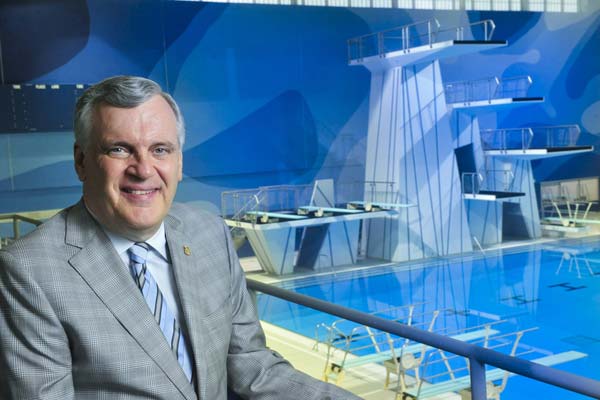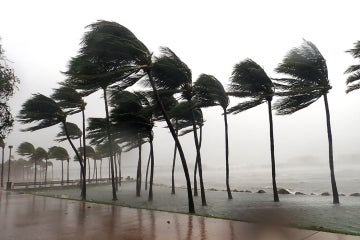
The Honourable David Onley, Special Ambassador for the Pan Am and Parapan American Games, at the state-of-the-art Toronto Pan Am Sports Centre at University of Toronto Scarborough (photo by Ken Jones)
David Onley: parasport is on the rise and here’s why
“No longer just an afterthought, but worthy of its own coverage and its own place in the sporting pantheon”
Published: August 5, 2015
With the largest-ever Parapan Am Games set to launch in Toronto on August 7, David Onley – Ontario’s former Lieutenant Governor and U of T’s Special Ambassador for the games – says some of the most exciting competitions have yet to hit the field.“
Parasport is experiencing a “tipping point moment” in terms of audience interest and support, Onley says, adding that in such a moment of change lies a powerful opportunity to transform cultural attitudes.
“Until you have seen a blind swimmer, until you have seen athletes competing in wheelchair rugby or wheelchair basketball, you don’t realize and can’t appreciate the raw athleticism of these individuals,” said Onley, in his preview to the Parapan Games for U of T News.
“As you watch that and get caught up in the excitement of the competition itself, it’s only when the play is finished and the applause dies down that the secondary aspect of it being a parasport hits you with a wallop.”
Onley explained his view of the trend ahead of the final week of competition at the Toronto 2015 Pan Am/Parapan Am Games.
London 2012 was the breakthrough Olympics for parasport – and interest is only getting stronger
Over the last number of years, probably the last 10 or 12 years, the impact of the Paralympics and the Parapan Games has increased quite dramatically. Here in Canada, Vancouver 2010 saw a significant growth in the television audience for parasport compared to Beijing in 2008 – and those numbers were already pretty good. But London’s 2012 paralympic games shattered ratings of any prior games, making them comparable in the coverage with that of the Olympic games.
It raised everyone’s awareness that parasport was no longer just an afterthought, but worthy of its own coverage and its own place in the sporting pantheon. Previously, the layers of sport were major league, minor league, amateur. Parasports, I would say candidly, were last to public consciousness – until Vancouver and London raised awareness to the point where people want to see and participate in these events simply because they know they’re going to see significant athletic displays.
Parasport’s transformative power thrives on education, policy, impact of broadcast on TV and web
Here in Ontario, increasingly awareness has come about from the Accessibility for Ontarians with Disabilities Act and the growth in courses at post-secondary levels (I’m thinking of programs at York, Windsor, Brock, Western and others, including a course I’m teaching this fall at UTSC on the politics of disability).
This combines with many other layers of support, including advocacy, government studies and more. But I believe the collective impact on a society is that, where all these other non-sport-related activities have been going on, we see athletic events on television and see that these are not disabled people who are attempting to put on some sort of an athletic demonstration or deserve sympathy. What we see instead are significant athletes who just happen to have a disability. And that’s a major shift, a significant shift.
When I see a blind skier shooting down the slopes with their guide alongside them, giving directions on where to turn and how hard to cut, I’m just blown away. I’m not thinking, “Well, look at that fine blind person.” I’m thinking, “How did that person do that?!”
Compare that to me sitting on a sit-ski device, which I have used in the past to go down the bunny hill and ended up breathless… to then watch athletes competing at that level, notwithstanding the fact of their disability, it’s quite a thing to see.
But what you’re looking at with these high-level parasport competitions is the athletic performance – the reality of the disability comes afterwards, or is put to the side. And that, ultimately, is the goal of all social and government policy relating to disability: to see the ability of the person, and take their disability as just another aspect of their personal characteristics alongside things like hair colour or eye colour.
Audience ratings continue to drive a positive feedback loop of support and interest in parasport
I would like to think Rio will be a very interesting test as to how far things can progress and it’s not that far down the road. London was the breakout event in terms of television coverage for parasport (and it’s too bad that we have to measure success on the basis of TV but it is a good measure). Since most of us won’t be able to get to Rio, we will be relying on TV.
Television responds to public demand. Public demand is what added additional hours of coverage by the CBC in the past few weeks to the Toronto Pan Am Games. And if public demand is there, there will be increased coverage of parasports, too, which leads to greater acceptance within the entire culture and community.
Canada is unique in its legacy of parasport heroes like Terry Fox and Rick Hansen
We are unique as a country that when we have any list of the top 10 or 20 icons or personalities in Canadian history that Terry Fox and Rick Hansen are always included. We’re the only place on the planet that has that. They truly were trailblazers and, in many ways, Rick continues to be with the ongoing contributions he’s making to spinal cord research.
They set the tone and they set the way and for athletes made it that much easier to get involved and be accepted. That’s what I hope will come about as we go through the ParaPans and Rio: that people will take it as an opportunity to see athletes who just happen to have a disability as opposed to tuning in with a sympathetic attitude, which, in a bygone era, was definitely the case.
The sympathy angle was a part of the cultural reality. It’s been a long, long process to be accepted as individuals and the athletes who have participated in these sports are the ones able to do that to a very real extent.
They capture the public’s imagination and attention. They keep up the process of changing attitudes from where people with disabilities receive sympathy to instead turn it to what it should be, where it’s just another part of the human condition. We still have a way to go on that, but parasport has a significant role to play.



